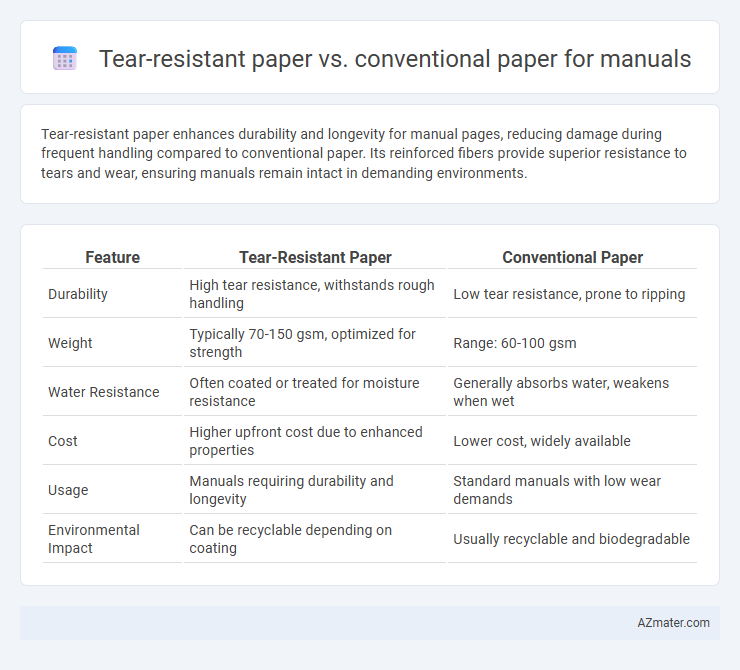Tear-resistant paper enhances durability and longevity for manual pages, reducing damage during frequent handling compared to conventional paper. Its reinforced fibers provide superior resistance to tears and wear, ensuring manuals remain intact in demanding environments.
Table of Comparison
| Feature | Tear-Resistant Paper | Conventional Paper |
|---|---|---|
| Durability | High tear resistance, withstands rough handling | Low tear resistance, prone to ripping |
| Weight | Typically 70-150 gsm, optimized for strength | Range: 60-100 gsm |
| Water Resistance | Often coated or treated for moisture resistance | Generally absorbs water, weakens when wet |
| Cost | Higher upfront cost due to enhanced properties | Lower cost, widely available |
| Usage | Manuals requiring durability and longevity | Standard manuals with low wear demands |
| Environmental Impact | Can be recyclable depending on coating | Usually recyclable and biodegradable |
Introduction: Understanding Paper Durability
Tear-resistant paper offers significantly higher durability compared to conventional paper, making it ideal for manuals exposed to frequent handling or harsh environments. This type of paper is engineered with reinforced fibers or synthetic additives that enhance its resistance to ripping, ensuring manuals remain intact over extended use. Conventional paper lacks these enhancements, making it more susceptible to damage, which can compromise the readability and longevity of important instructional documents.
What is Tear-Resistant Paper?
Tear-resistant paper is specially engineered to withstand ripping and tearing, making it ideal for manuals that undergo frequent handling and use. Its fibers are often reinforced with synthetic materials or treated with chemical coatings to enhance durability compared to conventional paper. This type of paper increases the longevity and readability of manuals, especially in harsh environments or for products requiring repeated reference.
Composition and Manufacturing Differences
Tear-resistant paper features a unique composition of synthetic fibers or reinforced cellulose that significantly increases durability compared to conventional paper, which primarily uses natural wood pulp. The manufacturing process of tear-resistant paper involves advanced bonding techniques and sometimes lamination to enhance resistance to tearing, whereas conventional paper undergoes standard pulping and pressing methods without reinforcement. These compositional and manufacturing differences make tear-resistant paper ideal for manuals that require long-lasting, rugged handling in various environments.
Strength and Durability Comparison
Tear-resistant paper offers significantly higher tensile strength and durability compared to conventional paper, making it ideal for manuals subjected to frequent handling and harsh environmental conditions. Its reinforced fiber structure resists ripping, moisture, and abrasion, enhancing the longevity of printed materials used in industrial or outdoor settings. Conventional paper, by contrast, tends to degrade quickly under stress, limiting manual lifespan and readability.
Applications of Tear-Resistant Paper
Tear-resistant paper is ideal for manuals used in harsh environments such as construction sites, factories, and outdoor settings where durability against ripping is crucial. It maintains integrity despite frequent handling, exposure to moisture, and rough conditions, ensuring the information remains legible and intact. Conventional paper often fails under such stresses, making tear-resistant paper the preferred choice for long-lasting, reliable manual applications.
Conventional Paper: Benefits and Limitations
Conventional paper for manuals offers cost-effective production and widespread availability, making it a practical choice for everyday documentation. However, its lower durability compared to tear-resistant paper results in increased wear and tear, especially in high-use environments. This limitation often necessitates frequent replacements or protective coverings to maintain the manual's readability and integrity.
Cost Analysis: Tear-Resistant vs Conventional Paper
Tear-resistant paper incurs higher upfront costs compared to conventional paper, but offers long-term savings by reducing replacement frequency and maintenance expenses for manuals. Conventional paper, while cheaper initially, often leads to increased costs due to frequent damage, reprinting, and labor. Evaluating total cost of ownership reveals tear-resistant paper as a cost-effective choice for environments demanding durability and longevity.
Environmental Impact and Sustainability
Tear-resistant paper significantly reduces waste by extending the lifespan of manuals, decreasing the frequency of replacements and lowering overall paper consumption. Its durability minimizes the environmental footprint through reduced deforestation and energy use compared to conventional paper, which often requires more frequent printing and disposal. Incorporating tear-resistant paper into manual production supports sustainable practices by promoting resource efficiency and reducing landfill contributions.
User Experience and Handling
Tear-resistant paper enhances user experience in manual handling by providing superior durability and resistance to frequent flipping and rough usage, reducing the risk of pages ripping or becoming damaged. Compared to conventional paper, it offers a smoother, more reliable tactile feel that supports repeated use in industrial or outdoor environments without compromising readability. Its robust structure ensures manuals remain intact longer, improving longevity and ease of use for operators and maintenance personnel.
Choosing the Right Paper for Manual Creation
Tear-resistant paper offers superior durability and longevity compared to conventional paper, making it ideal for manuals subjected to frequent handling or harsh environments. Its enhanced fiber composition resists ripping and wear, ensuring manuals retain readability and integrity over time. Selecting tear-resistant paper reduces replacement costs and improves user experience by maintaining a professional appearance throughout the manual's lifespan.

Infographic: Tear-resistant paper vs Conventional paper for Manual
 azmater.com
azmater.com